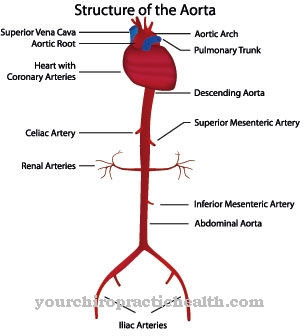In the Akrodermatitis chronica atrophicans Herxheimer it is a skin disease. The disease is chronic in the majority of cases and, due to its typical symptoms, fulfills the dermatological model of the final stage of so-called Lyme borreliosis. Akrodermatitis chronica atrophicans Herxheimer is counted among the atrophic skin diseases.
What is akrodermatitis chronica atrophicans Herxheimer?

Akrodermatitis chronica atrophicans Herxheimer got its name after a German dermatologist, Doctor Karl Herxheimer. The disorder will in some cases too Dermatitis atrophicans chronica progressiva or but Acrodermatitis chronica atrophicans called. Sometimes it is also short Herxheimer's disease called.
Basically, acrodermatitis atrophicans Herxheimer is a disease of the skin, which in some cases shows itself in the end stage or the third stage of borreliosis. Akrodermatitis Chronica Atrophicans Herxheimer occurs primarily in Europe, but also occurs in the United States and parts of Asia.
In the majority of cases, young adults and older women are affected by the disease. A connection between Akrodermatitis chronica atrophicans Herxheimer and Borrelia afzelii is seen in Asia and Europe.
causes
According to the current state of medical research, the cause of akrodermatitis chronica atrophicans Herxheimer is seen primarily in a special pathogen. It is Borrelia afzelii.
This pathogen belongs to the so-called Borrelia and occurs predominantly in Europe. For this reason, Borrelia afzelii often affects people who suffer from Lyme disease. Infection with borreliosis pathogens threatens in the late stages of the disease akrodermatitis chronica atrophicans Herxheimer.
You can find your medication here
➔ Medicines against skin redness and eczemaSymptoms, ailments & signs
Akrodermatitis chronica atrophicans Herxheimer is characterized by several typical symptoms and complaints that indicate the disease. However, the signs differ from patient to patient in terms of their individual appearance and severity. Basically, Akrodermatitis Chronica Atrophicans Herxheimer is characterized in the majority of cases by a progressive course.
The disease usually shows up in the area of the limbs and especially on the extensor sides of the legs. At an early stage, Akrodermatitis Chronica Atrophicans Herxheimer appears in the form of swelling and livid discoloration of the skin. Usually there are no other symptoms. In this case, lymphocytic infiltration can be detected in the course of histopathological examinations.
Later on in the disease, the subcutaneous tissue of the skin loses substance, which is also known as atrophy. As a result, the veins under the skin show up very clearly as they protrude more strongly. Overall, the skin makes a very thin impression, which is why the term cigarette paper skin is also used in this context.
In addition, there will be discoloration of the affected areas of the skin. Basically, the first symptoms of akrodermatitis chronica atrophicans Herxheimer develop a few weeks to several years after the first infection with Borrelia burgdorferi. The period of time is therefore relatively long and many patients do not remember the causative tick bite.
The swelling on the skin usually only shows up on one leg and is dark purple in color. However, other symptoms usually do not occur at the beginning of the disease. Later, the blood vessels shimmer under the skin and the skin in the area of the joints develops fibromatous thickenings.
An accompanying symptom of acrodermatitis chronica atrophicans Herxheimer is very often oligoarthritis or so-called monarthritis, which occurs in the area of large joints. The knee joint is often affected. In addition, the nerves are sometimes involved in the form of radiculoneuritis or axonal polyneuropathy. Tertiary neuroborreliosis is a potential complication. If nerves in the subcutaneous area are affected, localized disorders of sensitivity may occur.
Diagnosis & course
The diagnosis of akrodermatitis chronica atrophicans Herxheimer must always be made by a suitable specialist. As part of the diagnosis, the attending physician first takes a thorough anamnesis. Together with the patient concerned, he discusses the patient's medical history, possible previous illnesses as well as health complaints that occur frequently in the family.
Various clinical examinations are then carried out. In the case of acrodermatitis chronica atrophicans Herxheimer, tests are carried out to determine whether the patient has borreliosis. A skin biopsy can also be performed. A thorough differential diagnosis is particularly important. Diseases that need to be clarified are, for example, erysipelas or erysipelas carcinomatosum, acrocyanosis and eosinophilic fasciitis.
In addition, the patient should be examined for lymphoplasmocytoid immunocytoma and erythromelalgia. Other potential diseases are scleroderma as well as linear morphaea and scleroedema adultorum Buschke. Finally, uric arthritis can be ruled out, which sometimes manifests itself in similar symptoms.
Complications
Akrodermatitis chronica atrophicans Herxheimer is a chronic skin disease which occurs more in Europe than in the USA or Asia. It affects young adults as well as older women. Borrelia pathogens are assumed to be the pathogenesis. The first symptoms appear either within a few weeks or several years after infection with Borrelia pathogens.
A swelling of the skin on the leg with a dark purple color is clearly visible. After a short time the skin becomes visibly thinner and the blood vessels and veins shine through. This is accompanied by an inflammation of the knee joint. There are also fibroses on the joints. If the side effects are not clarified by a doctor in good time, the course of the disease becomes more complicated.
Chronic forms of joint arthritis, an inflammatory disease of the nerve roots of the spinal cord and the peripheral nervous system, develop. As a result, there is a risk of severe sensory disorders, attacks of fever and raging headaches. If the accompanying arthritic symptoms are already pronounced, the diseased synovial membrane is removed arthroscopically.
The procedure can cause further complications and requires a long healing process and independent drug treatment. The differential diagnosis can clarify whether acrodermatitis chronica atrophicans Herxheimer is due to borreliosis. A skin biopsy can also be performed depending on the severity of the case. If the symptom is not yet atrophic, high-dose antibiotics are given. Otherwise the disease is no longer considered to be medically treatable.
When should you go to the doctor?
Akrodermatitis chronica atrophicans Herxheimer must be treated by a doctor. As a rule, this disease does not lead to a positive course of its own, so that treatment by a doctor must be initiated in any case.
As a rule, the doctor should be consulted if there are various skin complaints, which in most cases occur for no particular reason. In most cases, those affected by akrodermatitis chronica atrophicans Herxheimer suffer from swelling or itching, which can spread to different regions of the body.
Furthermore, it is not uncommon for sensitivity disorders and paralysis of certain areas to occur. If these complaints occur, a doctor must be consulted immediately. As a rule, akrodermatitis chronica atrophicans Herxheimer should be treated by a dermatologist. The treatment is carried out with the help of medication and in most cases leads to success.
Doctors & therapists in your area
Treatment & Therapy
At the onset of akrodermatitis chronica atrophicans Herxheimer, penicillin G is administered in high doses. In addition to penicillin, cefotaxime can also be administered, which can be administered orally or as an infusion.
Outlook & forecast
Acrodermatitis chronica atrophicans Herxheimer causes a number of different complaints. Those affected suffer from severe swelling and discoloration of the affected regions. Pain can also occur, which can significantly reduce the quality of life. The skin appears very thin and can bleed due to simple external influences.
In many cases, the symptoms of akrodermatitis chronica atrophicans Herxheimer only appear at the end of the disease, so that the disease is not directly associated with a tick bite. It can also lead to paralysis and severe sensitivity disorders, which often lead to psychological complaints or even depression in the patient.
The disease can also lead to inflammation of the knee joints, which can lead to walking difficulties. The person concerned may then be dependent on the use of walking aids. Those affected also suffer from a severe fever and headache. The patient's resilience drops enormously.
As a rule, acrodermatitis chronica atrophicans Herxheimer can be treated relatively easily with the help of antibiotics. This will resolve all complaints. Life expectancy is also not reduced by this disease.
You can find your medication here
➔ Medicines against skin redness and eczemaprevention
Akrodermatitis chronica atrophicans Herxheimer cannot be prevented in every case. Tick bites are sometimes unavoidable. One possibility is the vaccination against Lyme disease.
Aftercare
As a rule, the options for follow-up care for akrodermatitis chronica atrophicans Herxheimer are relatively limited. With this disease, the patient is always dependent on medical treatment, whereby there is no self-healing. Since the disease is also contagious, contact with other people should be avoided until the symptoms and symptoms of Akrodermatitis Chronica Atrophicans Herxheimer have subsided.
Since the disease is usually treated with the help of medication, the person affected must take them regularly, whereby the possible interactions with other drugs should also be taken into account. When taking antibiotics, it should also be noted that they should not be taken with alcohol, as this will reduce their effect. Parents should also ensure that children take it regularly.
Since akrodermatitis chronica atrophicans Herxheimer can also lead to psychological complaints or severe depression, the person affected should talk to his friends or family about the symptoms. In serious cases, however, a visit to a psychologist is necessary. Furthermore, contact with other sufferers of akrodermatitis chronica atrophicans Herxheimer can also prove to be useful, as this can lead to an exchange of information.
You can do that yourself
Despite all efforts, Akrodermatitis Chronica Atrophicans Herxheimer is a disease with a chronic course. In the context of self-help, there are therefore insufficient possibilities that cause the person affected to heal. Measures can be taken to support general well-being, the success of which must be assessed individually.
If there are increasing changes in the skin's appearance in the further course, the doctor's instructions must always be followed. Akrodermatitis chronica atrophicans Herxheimer occurs in the end stage of Lyme disease. Therefore, medical care is usually already taking place and should not be interrupted. In addition, the patient's lifestyle can promote health. A balanced and healthy diet strengthens the body's immune system. This helps in dealing with pathogens and promotes recovery.
The use of cosmetic products should be avoided if possible. If they do not promote the healing process, the ingredients of the cosmetics can slow it down in the worst case. The garments should not be made of synthetic materials. It is necessary to change clothes every day and sweat should be well absorbed by the fabrics. If psychological irregularities arise due to the optical changes, large areas of the body can be well covered by the choice of clothing.


.jpg)

.jpg)








.jpg)

.jpg)
.jpg)











.jpg)